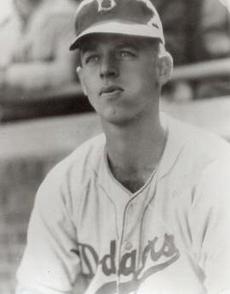

Cy Buker
Date and
Place of Birth:
February 5, 1919
Baseball
Experience:
Major League
Position:
Pitcher
Rank:
Unknown
Military Unit: US Army
Area Served: United States
Major League Stats: Cy Buker on Baseball-Almanac
 Cyril O “Cy” Buker was born on February 5, 1919 in
Cyril O “Cy” Buker was born on February 5, 1919 in He graduated with a Bachelor of Science Degree in
1940 and took a job in teaching but also decided to try his hand at
pro baseball. Buker signed with the New York Giants and was sent to
Buker’s elbow didn’t
improve that summer and he quite the game to return home and teach.
He continued to play semi-pro baseball with a local team as a second
baseman and gradually he arm recovered.
Buker decided to give
the professional game another try in 1942 and signed with
In the spring of 1944,
Buker received a call from
“I wasn't there two
days before I was in the Army,” recalled Buker. “The Army finally
released me about May 15. I was in what they call the observation
unit. I had asthma, and I was wheezing up a storm.”
Buker made his major
league debut on May 17. He appeared in 42 games during the season
and had an impressive 7-2 record and 3.20 ERA. The 26-year-old
rookie started only two games but won both, earning his first
victory by beating the Phillies in
Buker arrived late for
spring training in 1946 because of his teaching job in
Buker pitched for
Buker retired from teaching and coaching in 1970. He was inducted into the Wisconsin High School Football Coaches Hall of Fame and Wisconsin High School Baseball Coaches Hall of Fame.
Created December 17, 2007.
Copyright © 2015 Gary Bedingfield (Baseball in Wartime). All Rights Reserved.